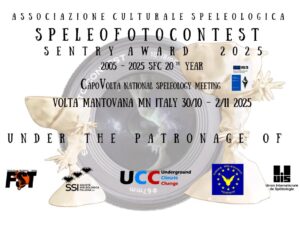What is the Sentry Award? An idea that was born at the end of 2021 and only materialized after a rather challenging journey, constantly plagued by doubts about whether it could be completed. The “Sentry Award” is the three-dimensional representation of the iconic stalactite called “Sentinella” guarding the Treasure Hall of the Ramo dei Lucchesi in the Antro del Corchia. It is also the symbol of the cultural association SpeleoFotoContest, which aspires to become a symbol of speleological excellence.

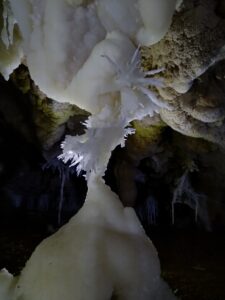
The Sentinella is as fascinating as it is fragile, embodying the millennia-old delicacy of the underground world and, therefore, the importance of its preservation to promote awareness, especially beyond the speleological community. This is why, after a long gestation period, a project was developed first for a three-dimensional survey and then for its processing to print a resin model representing it.
Thanks to the essential collaboration of Daniele Pagli and Paolo Billeri from the Gruppo Speleologico Torrentistico Speolo di Fucecchio FI, several preliminary tests were conducted to determine the best solution to overcome the project’s various technical challenges. Chief among these was the issue of transporting the necessary equipment to the site, refining the technique to be used, and, last but not least, considering the financial aspects.
Given all these uncertainties, photogrammetry was chosen as the technique, utilizing cameras and smartphones to capture multiple series of images. These would then be processed using software and a specialized application. The initial home tests yielded only partially satisfactory results: simulations showed that precise “targets” were necessary to enhance the resolution of the 3D image details. This was particularly crucial in low-light conditions and on surfaces with smaller details. Under normal circumstances, this issue could be easily resolved, but in such an exceptional environment, it became a daunting challenge. Covering the Sentinella with adhesive targets was certainly not an option!
A solution had to be found, and that was when Daniele had a literal “lightbulb moment”: “Why don’t we try laser pointers?” Bingo! A practical, cost-effective, and efficient solution that also ensured the Sentinella’s safety. Three grid-patterned laser pointers, strategically positioned on tripods around the subject, would create a network of fixed reference points in the photographs. This method significantly improved the precision of the final 3D model’s details.
Everything was finally in place—the method had been fine-tuned, and it was time to put it into action. In early March, on the designated day, a team composed of Daniele, Paolino, Pallina (Sandra), and Nedo (Luca) geared up, filled with both determination and hope for success. They embarked on the “Risalita dei Lucchesi,” carrying their equipment. Upon reaching the top, they obeyed the sign that read: “WARNING: You are entering an extremely delicate area. Forget that you are human.” They left behind any climbing gear that could potentially harm the environment and began setting up the “stage.” The effect was mesmerizing—worthy of the best psychedelic show—as the green dot grid illuminated the cave. Turning off all other lights, they were also treated to an unexpected spectacle: “photon rays” created by the vapor from their heated bodies after the climb (see photo gallery).
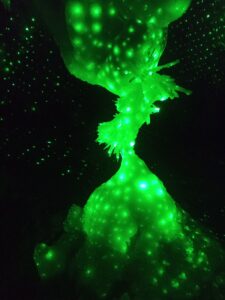
Numerous photos were taken with both a camera and a smartphone to generate two sets of images for processing, one via a computer and the other through the smartphone app. To everyone’s surprise, the app—initially met with skepticism—proved to be extremely practical and efficient, even allowing for an on-the-spot preview of the processed model. The hard part was now over. After the customary group photo, they packed up and left, aware that they were mere intruders in that fragile, marvelous place and had to leave as soon as possible.
The team and... Her!
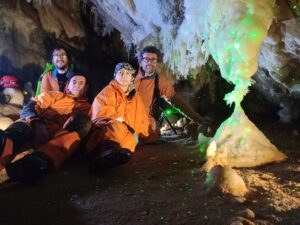
Model preview
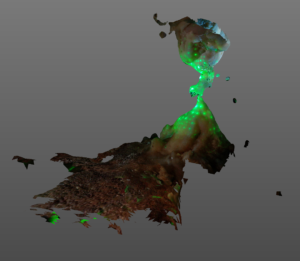
Once acquired, the digital model needed to be “cleaned,” “repaired,” and “made printable”—a task that turned out to be far more challenging than the survey itself.
Nearly three months of struggles with 3D modeling software and failed print attempts made it seem as though fate had decided against their success. One test print had worked, but it was in PLA and only 3 cm high. The overhanging upper part made larger prints extremely difficult, leaving white resin as the only viable option. Even with the advice of a specialized forum, printing seemed impossible until Paolo Dori—one of the founders and honorary president of SpeleoFotoContest, as well as the 3D printing technician—made an announcement: “It’s printing! It will take about 6–8 hours.”
The wait felt endless. Unfortunately, the worst news arrived: “A part detached halfway through.” A last desperate attempt was made, reducing the print speed by two seconds per cycle. It was 12:00 PM on June 1, 2022—less than 24 hours before the opening of the XXIII National Speleology Congress in Ormea, where the award was scheduled for its official unveiling. The estimated print time was still 8–10 hours for an 11 cm Sentinella. By 11:00 PM, the process was only 80% complete, meaning they wouldn’t know the result until the morning of the opening.
At 6:29 AM on June 2, the long-awaited message arrived: “Habemus Sentinella!” They could hardly believe it! Months of dedication and struggle had finally paid off, just in time for the official presentation during the Contest’s award ceremony.
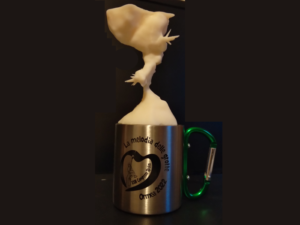
What Will the Sentry Award Become? It is hard to predict. For now, it is a challenge we are proud to have completed through teamwork and perseverance. We will see where it goes from here. One thing is certain: if the Sentinella Award has a future, it will always be dedicated to spreading speleological knowledge, whether through photography or other means. The cultural association SpeleoFotoContest has now gained a central new element in its activities—one we hope will help foster a greater appreciation for cave conservation and the karst environment.




